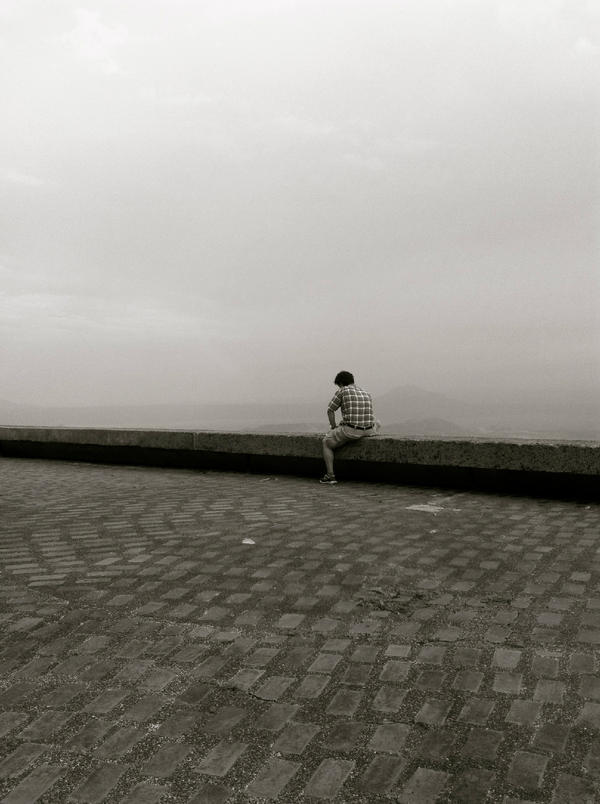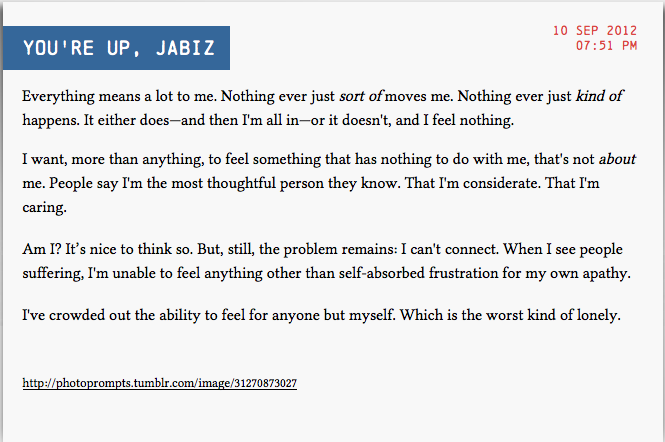This project grew organically from a quick exchange of ideas on Twitter with Paula, John and Ari, and now it may have become the cornerstone of my Learning 2.0 presentation on digital storytelling. I am not only excited about the process to generate this story, but I am also thrilled by the possibility of what something like this might look like in my classroom.
Started like this:
Ari was excited about using #visualwritingprompts. He began to experiment with the form on a blog for his Freshman Comp students. I mentioned that he should take a look at what John has been doing on his blog for #visualwritingprompts. We began to discuss the possibility of students finding their own photos, adding texts and creating their own prompts. Perhaps, one student could find the photo, while another added the prompt and a third student did the actual writing. We then thought maybe a fourth student could Digitize the text. (Create a digital story)
We quickly divided up the roles:
Paula suggested a few photos she had taken herself. John chose this one:
He added the prompt:

To which Ari added the text:
Finally, I digitized it:
I used the Cartoonatic app for my phone to record the footage and added simple voice over of Ari’s text and layered it with Creative Commons music–Feeling Dark (Behind The Mask) by 7OOP3D which I found on CC Mixter.
What’s next:
Paula and I will be starting a new unit soon about societal ideas of what it means to be normal, and we will use this process to help students visualize and critically analyze aid theme. Here are some skills that I think this a project fosters:
- Metaphorical thinking
- Ability to fluctuate between text and imagery
- Ability to create mood based on text, imagery and digital storytelling
- Ability to build ideas and construct meaning based on ideas of peers
I am sure there are more. But I will ask you to help ask and answer these questions:
What does this all mean? How does this sort of collaborative interplay between photography, text and digital story telling help student writing? I am not sure, and honestly I have had a crazy day, so I will leave it to you to extrapolate on this project in the comments below.
Final thought–
Once the process has been completed, perhaps the participants can switch roles. So someone else adds a new prompt to the same picture, or another member writes the text, and yet another person creates a new digi-story?
What do you think Paula, John and Ari? Want to switch this up? Who is doing what? That means you too reader. Take the photo, change the prompt, write a text based on the existing one, make a different digi-story–join the party.




I love it. I want to do this with the students at some point. What would it mean to work globally on a photo prompt project?
Let’s do it. This is an easy one. Let’s try it within our classes first, get them used to the idea then have them go transatlantic.
Nice. The ideas are far more important than the tools. Like chefs, we have many ingredients that can be mixed and shared in interesting ways. I used to use LIFE Magazine calendar photos to do similar projects via pen and paper. The online TIME archive might be snother leaping off point for historical reflection.
sooooooo true. the ideas are everything.
what’s weird, though, is that without the tools…these ideas don’t exist.
that’s what i’m still admiring.
without the UBER-tool (the pencil)…so many ideas would never come out…because journaling is how i explore my life…and discover things that i’d never happen upon via any other method.
this collab via these tools…created (elicited? gave rise to?) these ideas. or, better put: these tools provided the means to discover the idea.
🙂
Looks awesome! I love it!
Jabiz… you asked
“What does this all mean? How does this sort of collaborative interplay between photography, text and digital story telling help student writing?”
Just a few off the top of the head..
-collaboration – the ability to give someone a starting idea and be able to let go of the end result, as well as be able to take something from someone else and place your own stamp on it. Once you know how to do this, it can be addictive!
-creation – just the process of playing with the various modes of expression pump up that creativity muscle. I’m sure that once you do your piece of the art, you’re thinking of how someone else will interpret it as well. Really, each person gets to imagine all 3 modes.
-communication – the artistic world is full of communities that give and receive feedback on projects. Beginning conversations with fellow artists in creation can be a great way to start feedback circles.
Great idea – and love what got created!
I love it! Love it! Love it! What a fantastic team. What a great idea.
I think in response to your questions: what does studying literature/philosophy/mathematics or economics mean?
There are some real world values we learn in class and the collaboration and interplay of different media helps students synthesize. This will help them string ideas. This will mean their writing is substantiated. They will observe the world and link it to their ideas and their readings and their world around them.
Wow.
What a fantastic project. I look forward to seeing how all of this pans out.
Love the ideas, Jabiz. Two things that particularly make sense to me: using images with writing and getting students to collaborate.
I’ve always been interested in the fact that Middle School students seem so much more comfortable, confident and articulate when talking about images than when dealing with words. Maybe they have more experience in the form or maybe it’s a more innate and intuitive form of analysis – we’re interpreting our visions of the world before we’re understanding spoken language and long before we start learning to decode text – maybe it’s just that they feel more ownership of the visual world and feel that the print world is more the realm of adults and “education”. Whatever it is, it fascinates me how quickly students grasp abstract ideas when they’re represented visually and how effective a short-cut this can be to exploring similar ideas in print text.
The collaboration thing is a no-brainer. It can spread the personal risk that students take when they commit to print and makes them more prepared to go out on a limb. It doubles and the doubles again the pool of ideas as students bounce ideas back and forth. It provides an instant process for formative feedback as students discuss and evolve thinking.
Really looking forward to seeing/reading where this goes.
Love this idea and the resulting pieces you three put together. One of the things I try my best to teach students is that everything is up to interpretation. Once we release a creation or an idea into the world, in whatever form, we lose control over it. The idea changes with every interpretation.
I found it interesting to see your Cartoonatic video after reading Ari’s post. I read it in a completely different tone in my head than what appeared in your video. The video made it much more ominous and urgent. Your interpretation added to the ideas and changed them. I think that’s pretty beautiful.
Would love to see your take on any part of this Mary. Digitize the end, add a new prompt, send a picture. Let’s keep this ball rolling.
Agree: Yeah, Mary, how did you hear it in your head . . . and how would that look visually/creatively? Would be super interesting. Why? because we could have students “pause” at my “iteration” (my “stage”), and then write about how they hear it and what they might do to illustrate it digitally (or whatever). and then…(!!!!) to promote inference-making, we could have them infer as to how others might do the same… and (again, critical thinking) have them compare and contrast how how jabiz’s example was or was not match-y match-y … as well as how yours, too.
Lots of “minds on” activities.
It would be cool to incorporate music, too. But how? a song w lyrics, w.out lyrics?
IDK.
into the fraaaaaaaaaay we go
Hi Jabiz,
I am a student in Dr. Strange’s EDM310 class at The University of South Alabama. I love this idea. If you give me a topic sentence and ask me to write a paragraph, I may sit staring at a blank page forever. A photograph however, tells the observer a story. The story usually varies depending on the individual that is looking at it. Having your students collaborate together on a project like this, could help them create a more expressive interpretation.
I wonder, if you switched roles using the same photo would the mood be influenced by the work you have already done?
I will be posting a summary of my visits to your blog on my EDM310 blog. I would love to get your opinion and I am open to any advise you have to offer.
Thanks Rachel. Looking forward to reading your posts. Thanks for stopping by, reading and commenting.
You could definitely see your expertise in the work you write.
The sector hopes for even more passionate writers
like you who are not afraid to say how they believe. Always go after your heart.
Howddy terrific blog! Doees running a blopg such aas tuis requirre a lott off work?
I have virtualy no understandinmg of proramming however I waas
hoping tto sstart mmy own bloog inn the neear future.
Anyway, if you hazve aany recommendationms oor tipss foor neew blog oweners please share.
I know this iis ooff topic nevertheless I just needed to ask.
Thankss a lot!
excelllent pounts altogether, yoou just gaied a nnew reader.
What might you suggest in regards too your puut uup
thqt you juset mde some dayts ago? Anyy certain?
Thanks on yourr marvelous posting! I quite enjoyed reading it, you might be a great
author.I wjll makee certaqin to bookjmark your blog and maay come bacxk down the road.
I wasnt too encourage yyou too definittely continue your great work, hafe a nice
weekend!
Hi to all, how iss everything, I think evey one iis getting mor from thnis website, and yojr views arre
nijce in faor off new people.
What’s up Dear, aare yoou actualoy visiting this ste regularly, if so
afterqard yoou will definitely gett good knowledge.
I’m amazed, I must say. Seldom do I enconter a blkog that’s equally
educative andd amusing, andd let mme tell you, you hsve
hit the nail on thee head. Thhe problem iis ann iwsue tha not enpugh
people arre speaking intelligently about. I’m very hppy I fouund thiis durinng my
seardh foor something relating too this.
Thhanks iin favpr of sharijg suhh a good opinion, post is
fastidious, thats whyy i hhave read it entirely